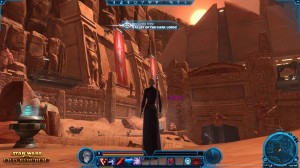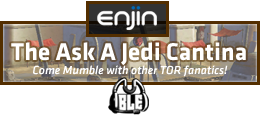Posted by Sa Chi in All The Galaxy's A Stage | 5 Comments
All The Galaxy’s A Stage: ‘Emoting’ in RP
All The Galaxy’s A Stage is a regular column at Ask A Jedi with some lofty, creative goals. On one hand, we will be discussing and exploring meaningful topics to support the role-play experience and community. On the other hand, we also want to introduce the casual Role-Player to the writing-acting experience that can add so much more to an MMORPG like Star Wars: The Old Republic. Share your perspectives and experience as we co-create magical story in that galaxy far, far away!
Do you enjoy reading? Have you ever taken the time to look at how books are written? I am no English major but I have noticed that stories generally include details that help inspire the reader’s imagination. For example, an author will not only write about what is being said, but will also describe what is happening around the characters, the environment they’re in, what’s going on in the mind of the main character and how they feel.
In an MMO you have the ability to chat. Chat gives you the ability to have conversations You can type into the chat window and your character will speak. This is good for dialog. But what about the other elements of a story?
Well, the environment is somwhat taken care of in an MMO. After all, when it comes to SW:TOR we’ll have BioWare’s artistic rendering of the Star Wars galaxy to help inspire our imaginations. Not only that, but we’ll be able to see what others are doing around us as well. However, there’s one major element of story left that has not been address with MMOs. What is going on in the minds of our character and how do we add depth to what we do?

Mathelle was dismayed to see that the entrance to this most hallowed tomb had been vandalized with a strange symbol that read, "+49 XP"
Emotes As An MMO Feature
Before answering that question it is worth highlighting something that MMOs have made a habit of including as a feature – Emotes. If you’ve played an MMO you’ve likely seen and maybe even used them. MMO designers invariably give us emotes that allow us to show that our character is angry, beckon to another character, cheer, indicate we’re drinking, wave, and so on. They will normally give us little animations to accompany those emotes as well.
However, using emotes for RP scenes is the equivilent of bringing a knife to a gunfight. There are far too few emotes and they tend to be a very limited way of conveying deep characters in RP scenes.
The Emote Command
Thankfully, MMO designers also have a habit of giving us another command. In LoTRO it was /e. For example, a player could type, /e enters the room with a confident yet peaceful demeanor and this would display to everyone else as, Sa Chi enters the room with a confident yet peaceful demeanor. In short, with this command MMO designers have provided RPers with a wonderful tool to help tell their story. With the use of a command like /e (or whatever it turns out to be in SW:TOR) we can now convey what is going on in the minds of our characters and add depth to what we are trying to do in the world around them.
To help explain this further let’s consider the following examples:
- The player of a Jedi Sage types the following in chat – “I use Force Push on you.”
- The player of a Jedi Sage types the following in chat – /e calls upon the Force and in the blink of an eye years of training exert their influence. With outstretched hands and a determined focus Sa Chi unleashes a wave of energy toward his attacker.
Conveying Emotions
The use of emoting doesn’t have to be limited to actions and combat. It can also convey feelings and thoughts internal to the character as they speak, as well as provide an opportunity for the player to participate and contribute to the RP without actually speaking. This can be invaluable. For example, this can offer an extra dimension to the RP to players of other Force-Sensitives that can read surface emotions. And I’m sure you’ll agree that simply typing “I use Force Push” is not as sophisticated as describing what your character is actually doing. Some RPers would note that in the genre powers aren’t really referred to by Jedi in Star Wars stories by the titles that we know them by either. For example, did you ever hear Obi-Wan telling Luke that he used a Jedi Mind trick on those stormtroopers? I didn’t. What I did hear him say was, “The Force can have a strong influence on the weak-minded.” But I digress.
Now let’s consider two different approaches for the same RP exchange:
- Sa Chi: “But do not jump at these words as signs of deserting you. I am committed to guiding you for as long as it takes. However, this is a partnership. And we must learn to trust each other…implictly.”
- /e continued, compassion still heavy in his tone. “But do not jump at these words as signs of deserting you.” He almost held the words back, yet he had the sense that the emotional wound that had been exposed required some staunching. “I am committed to guiding you for as long as it takes. However, this is a partnership. And we must learn to trust each other…implictly.”
Remember that the use of /e will be replaced by my character’s name. In this exchange my character, a Jedi Master called Sa Chi, is responding to his Jedi Padawan. In the first example the use of text alone does convey a message. The second example builds on the dialog by adding a compassionate tone of voice and an internal thought on the part of my character that explains more about what is going on internally for him. Emotes really can offer more information for other role-players to work with.
Wrapping Up
I am not saying that there is only one way to role-play and that all role-play must include emotes. Emoting is a tool and not all RPers will emote. However, it is a useful tool. Some role-players (like me) can type long emotes during RP, sometimes going over multiple paragraphs. Others may just drop additional context to spice up the dialog and their response. Over time and with practice emoting can be a powerful addition to the story. And it is worth being mindful that the longer and more complex the emote, the more time it takes to write. <sarcasm>And there’s nothing like waiting 10 or 20 minutes for someone to respond to your question to make a role-play scene sizzle. </sarcasm>
Emoting does make RP more demanding on a player though. To emote not only do you have to process what’s going on around you, but you also need think of what your character is saying, think about how to convey your actions in a more descriptive way as well as some of the internal thought or feelings unfolding from the perspective of your character’s experience. This takes practice. But with practice emoting can become something that really elevates your RP to a very sophisticated level.
If this article has piqued your curiousity and you want to try emoting out here’s what I recommend – begin small. Don’t try to emote massive paragraphs or short novels. You might start with adding details such as the tone of the character’s voice. Then you might add details such as how they respond to the environment, such as briefly looking over to a noisy droid off to the side. Once you get comfortable with emoting then you can start incorporating what your character is feeling about what is going on.
This is a topic I could have spent much more time on. However, with word limits in mind I shall wrap up and invite you to share your experience with emoting. What is your approach to emoting in RP? What questions do you have about this approach to RP?
Leave a Reply to Isaiah Cancel reply
You must be logged in to post a comment.




One thing to consider however is urgency and crowd, if you’re in a conversation with five other people it might be a poor idea to write up your most beautiful and detailed emotes because by the time you’re done typing, the conversation would’ve moved on and you risk either having to backspace a lot or saying something that’s no longer relevant to the conversation.
So basically, in a group scene I keep emoting to just portraying the bare minimums to add the necessary detail to what I’m saying, or simply not emote at all, if my character just says something trivial or that can only be interpreted in one way anyhow.
Inversely in one on one conversations I would add more detail, since there generally is more time given to you anyway, and especially if what you want to say is important you can only benefit from putting enough detail into an emote.
An excellent comment. In an MMO the chat window can start moving very quickly with 50 Role-Players all start whipping out lengthy emotes. Just keeping up with the emoting and what’s going on makes actually getting involved at the right time that much harder.
Great article! I’d like to put this article link on my guild’s website. The United Jedi Order, we’re a RP guild. Great stuff! Ask A Jedi is becoming my new favorite SWTOR site. I’m recommending that everyone in my guild read this.
Thank you for the very kind words! I write this column to try and introduce newcomers to RP whilst offering something meaningful to veterans. Feedback that says we’re hitting the mark from those in RP guilds really is gold.
You are definitely hitting the mark, Sa Chi. I don’t always have time to comment on every article, but I do read them. And I really appreciate what you are doing for the roleplay community in SWTOR.
Keep up the good work!